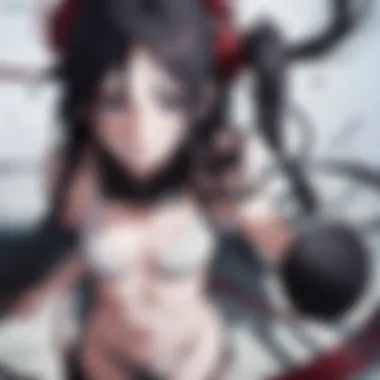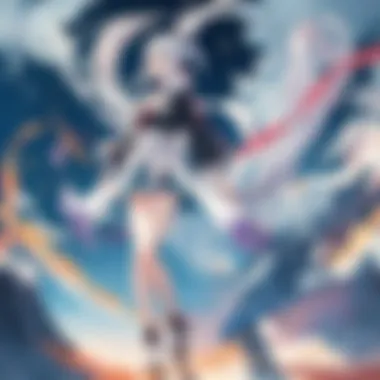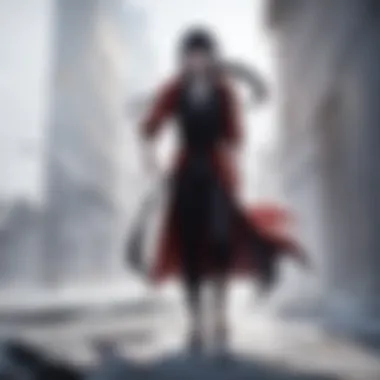Embarking on a Visual Odyssey: The Enigmatic World of Naruto Explored Through Pictures


Anime Series Overview
Character Analysis
In this section, readers will find a detailed analysis of the main characters in Naruto, exploring their multifaceted personalities, motivations, and contributions to the storyline. The intricate dynamics and relationships among the characters are intricately examined, shedding light on their impact on the overarching narrative and prevalent fan theories that have emerged around them.
Genre Spotlight
Embark on a journey through the specific genre of Naruto, uncovering its roots, evolution, and significance within the anime industry. This section highlights notable series within the genre, drawing comparisons and distinctions to provide a comprehensive understanding of Naruto's thematic and stylistic influences.
Behind-the-Scenes Insights
Discover the intricacies of Naruto's production process, from initial concept to the final screen adaptation. This section offers insights into the challenges encountered during production, along with the key success factors that have contributed to Naruto's enduring popularity among anime enthusiasts.
Introduction
Embarking on a visual journey through the world of Naruto unveils a realm of captivating imagery that transcends traditional storytelling. In this article, we explore the significance of visually experiencing Naruto's universe, delving into character depth, setting intricacies, and the essence of iconic moments captured in images. By unraveling the visual tapestry of Naruto, readers are offered a unique perspective that goes beyond mere words.
Understanding Naruto as an Anime Phenomenon
Brief History of Naruto
The evolution of Naruto from its inception to its current iconic status is a testament to its enduring legacy in the anime world. Tracing back the origins and growth of Naruto unveils a narrative that resonates with fans worldwide. The strategic decisions and character developments throughout Naruto's history have paved the way for its unparalleled popularity and cultural impact, making it a pivotal subject for this visual exploration article.
Impact on Pop Culture
Naruto's influence on popular culture extends far beyond the realm of anime and manga. Its widespread impact has permeated various facets of society, from fashion trends to societal norms. Observing how Naruto has shaped contemporary culture offers valuable insights into the power of storytelling and character-driven narratives. Exploring these influences within the context of visual representation provides a deeper understanding of Naruto's significance in the cultural landscape.
Significance of Visual Representation
Power of Visual Storytelling
Visual storytelling in Naruto transcends mere illustration; it encapsulates the emotions, dynamics, and essence of characters and scenarios. The visual intricacies woven into each frame convey a depth of narrative that resonates with viewers on a profound level. By immersing in the visual tapestry of Naruto, audiences are not only entertained but also invited into a visually rich world that stimulates the imagination and emotions.


Emotional Connectivity Through Images
Images in Naruto serve as conduits of emotional resonance, forging a profound connection between characters and viewers. The depth of emotion conveyed through visuals amplifies the impact of storytelling, creating moments of empathy, excitement, and introspection. Exploring the emotional potency of images within Naruto's narrative framework offers a glimpse into the depth of character portrayal and storytelling finesse.
Character Portraits
Naruto Uzumaki
Evolution of Naruto's Character Design
The evolution of Naruto's character design plays a pivotal role in shaping his identity throughout the series. From a young and energetic ninja to a mature and resilient hero, Naruto's character design reflects his growth and development. The progression in Naruto's appearance mirrors his emotional and psychological evolution, resonating with the audience on a profound level. The choice to alter Naruto's physical attributes over time adds a dynamic element to his character, symbolizing his journey towards self-discovery and fulfilling his destiny.
Iconic Expressions and Poses
Naruto's iconic expressions and poses are key features that define his character and leave a lasting impact on viewers. Whether displaying determination in the face of adversity or exuding joy in moments of triumph, Naruto's expressions convey a range of emotions that resonate with fans. His signature poses, such as the Rasengan stance, symbolize his strength and unwavering resolve. These iconic elements not only showcase Naruto's personality but also enhance the visual storytelling aspects of the series, adding depth and intensity to his character.
Sasuke Uchiha
The Brooding Persona of Sasuke
Sasuke Uchiha's brooding persona is a central aspect of his character that contributes to the overall depth of the narrative. His stoic demeanor and internal struggles create a sense of mystery and complexity around him. Sasuke's brooding nature adds layers to his character, hinting at inner turmoil and conflict that shape his decisions and actions. This nuanced portrayal of Sasuke captivates the audience, drawing them into his intricate character arc and the complexities of his relationships.
Dynamic Visuals in Sasuke's Battles
The dynamic visuals in Sasuke's battles are a visual feast for fans, showcasing his prowess as a skilled shinobi. From lightning-fast movements to powerful jutsu techniques, Sasuke's battles are artfully depicted with fluidity and detail. The visceral nature of these visuals intensifies the action scenes, immersing viewers in the heart-pounding excitement of each confrontation. The strategic use of angles and perspectives enhances the impact of Sasuke's battles, illustrating his agility and tactical brilliance on the battlefield.
Sakura Haruno
Strength and Grace in Sakura's Portrayal
Sakura Haruno's portrayal exudes a perfect balance of strength and grace that sets her character apart. Her evolution from a budding kunoichi to a formidable warrior showcases her resilience and determination to grow. The depiction of Sakura's strength in both physical combat and emotional resolve resonates with audiences, inspiring admiration and respect. The gracefulness of Sakura's character adds a touch of elegance to her portrayal, highlighting her femininity without overshadowing her capabilities.
Impact of Sakura's Character Development


The impact of Sakura's character development lies in the nuanced progression of her personality and skills throughout the series. From overcoming self-doubt to honing her abilities as a medical ninja, Sakura undergoes substantial growth that symbolizes perseverance and dedication. Her journey from a supporting role to a leading figure in pivotal moments demonstrates her transformation into a strong and independent character. The evolution of Sakura's character development enriches the narrative of Naruto, showcasing her as a pillar of strength and resilience within the storyline.
Scenic Beauty
In the exhaustive exploration of Naruto through pictures, the aspect of Scenic Beauty plays a pivotal role in capturing the essence of the anime's world. Within this article, the focus on Scenic Beauty aims to provide readers with a profound insight into the visually striking backdrops and settings that contribute to the overall narrative of Naruto. By emphasizing the specific elements of Scenic Beauty such as intricate landscapes, architectural details, and mood-setting weather effects, readers can immerse themselves in the rich visual tapestry that forms the backdrop of Naruto's adventures. The inclusion of Scenic Beauty not only enhances the aesthetic appeal of the article but also serves to underscore the significance of environment in shaping the characters and storyline of the anime.
Hidden Leaf Village
Architectural Marvels in the Village
When delving into the Architectural Marvels in the Hidden Leaf Village, one cannot overlook the meticulous detail and unique design elements that define this iconic setting within the Naruto series. The architectural marvels in the village serve as more than just a backdrop; they represent a fusion of tradition and innovation, reflecting the values and history of the Naruto universe. The intricate structures, from towering pagodas to humble dwellings, showcase a blend of craftsmanship and artistic vision that adds depth and authenticity to the village setting. By exploring the architectural marvels in the Hidden Leaf Village, readers can appreciate the thought and creativity that go into world-building in anime, enhancing their understanding and connection to the Naruto universe.
Mood-setting Weather Effects
An often underappreciated aspect of anime visuals, the Mood-setting Weather Effects in Naruto play a crucial role in setting the tone and atmosphere of key scenes. By immersing readers in a world where weather is not just a backdrop but a storytelling device, the article aims to highlight the impact of weather on mood and emotion within the narrative. Whether it's a sunlit day illuminating the village or a storm brewing on the horizon during a pivotal moment, these weather effects add depth and intensity to the viewer's experience. By examining the Mood-setting Weather Effects in Naruto, readers gain a deeper appreciation for the attention to detail and symbolism inherent in the visual presentation of the anime.
Land of Fire
Natural Landscapes and Environments
Within the Land of Fire, the natural landscapes and environments depicted in Naruto offer a breathtaking backdrop against which the characters' adventures unfold. From lush forests to rugged mountains, these diverse environments not only enhance the aesthetic appeal of the series but also serve as thematic elements that mirror the characters' growth and challenges. By spotlighting the key characteristic of Natural Landscapes and Environments in the Land of Fire, this article seeks to underscore the integral role that nature plays in shaping the narrative of Naruto. Through a detailed analysis of these natural landscapes, readers can better appreciate the synergy between character development and environment in the anime.
Symbolism in Fire-related Imagery
Fire-related imagery in Naruto goes beyond mere visual effects; it embodies layers of symbolism that enrich the storytelling and character dynamics. The Symbolism in Fire-related Imagery, whether through the fiery clashes of battle or the flickering warmth of a campfire, conveys themes of passion, power, and transformation within the narrative. By dissecting the symbolic significance of fire in Naruto, readers can unravel deeper meanings embedded in the visuals, gaining a more nuanced understanding of the characters' motivations and conflicts. Through a focused exploration of Symbolism in Fire-related Imagery, this article aims to shed light on the narrative depth and artistic sophistication of the anime's visual language.
Iconic Moments
Clash Between Naruto and Sasuke
In the climactic clash between Naruto and Sasuke, the visual intensity of the battle emerges as a defining element in this article. This intense confrontation between two lifelong rivals encapsulates raw emotion, fierce determination, and profound character growth. The vivid portrayal of lightning-fast combat sequences, charged with elemental powers and strategic maneuvers, intensifies the viewer's immersion in the high-stakes conflict. Such visual intensity serves to highlight the complexity of the characters' intertwined destinies while underscoring the thematic depth of their rivalry within the overarching narrative of Naruto.
Visual Intensity of the Battle


The Visual Intensity of the Battle not only heightens the adrenaline-pumping action sequences but also conveys the sheer weight of the characters' decisions and sacrifices. Through dynamic camera angles, kinetic illustrations, and detailed panel layouts, the visual intensity of this battle transcends mere spectacle, offering viewers a profound insight into the characters' inner struggles and external challenges. The strategic use of color palettes, lighting effects, and motion lines further enhance the dramatic impact of each frame, elevating the battle to a compelling cinematic experience within the visual medium of Naruto.
Emotional Impact on Fans
The emotional impact on fans stemming from the Clash Between Naruto and Sasuke goes beyond mere entertainment value, forging a deep emotional connection with viewers. As fans witness the raw emotions, personal conflicts, and poignant revelations unfolding during this intense battle, they are enveloped in a myriad of feelings ranging from excitement to sorrow. This emotional rollercoaster not only binds fans closer to the characters but also resonates with universal themes of friendship, rivalry, and self-discovery. The lasting emotional impact of this iconic moment reverberates throughout the Naruto fandom, solidifying its status as a timeless testament to the power of visual storytelling.
Naruto's Rasengan
Naruto's Rasengan stands as a visual emblem of his growth, determination, and prowess throughout his arduous journey. This iconic chakra technique symbolizes Naruto's unwavering resolve, innate talent, and relentless pursuit of becoming the Hokage. The detailed depiction of the Rasengan serves as a visual motif for Naruto's evolving skills, strategic ingenuity, and profound connection to his mentor Jiraiya. By exploring the nuanced layers of the Rasengan's symbolism, we gain insight into Naruto's multifaceted character arc and his transformative growth as a shinobi.
Detailed Depiction of Chakra Technique
The Detailed Depiction of the Chakra Technique not only showcases the intricate hand seals, spiraling energy patterns, and concentrated power of the Rasengan but also underscores Naruto's mastery of this formidable technique. Each frame meticulously captures the turbulent nature of chakra manipulation, emphasizing the precision and control required to unleash the Rasengan's full potential. Through the juxtaposition of close-up shots, kinetic energy lines, and visual effects, the Rasengan transcends its status as a mere combat technique, evolving into a symbol of Naruto's indomitable will and unwavering determination.
Symbolism of Naruto's Growth
The Symbolism of Naruto's Growth embedded within the Rasengan extends beyond its physical prowess to reflect Naruto's personal evolution, resilience, and maturation as a shinobi. This iconic chakra technique not only represents Naruto's bond with his mentor, Jiraiya but also embodies his capacity for growth, adaptation, and self-improvement. The symbolic significance of the Rasengan resonates with fans on a profound level, inspiring them to persevere in the face of adversity, embrace their inherent strengths, and forge their destinies with unwavering conviction. Through the lens of the Rasengan, viewers bear witness to Naruto's transformative journey, echoing their own aspirations for growth, discovery, and self-realization.
Artistic Analysis
In the intricate realm of Naruto, the Artistic Analysis section serves as a beacon illuminating the nuances of visual representation. By dissecting color palettes and composition techniques, this segment unveils the underlying brilliance of Naruto's imagery. Artistic Analysis in this article extends beyond aesthetic appreciation; it delves into the meticulous craftsmanship behind each frame, offering a deep insight into the creative choices that shape Naruto's vivid tapestry. Through a detailed exploration of color palettes and composition techniques, readers are invited to unravel the visual language of Naruto, thereby enriching their viewing experience.
Color Palette in Naruto
Meaning Behind Color Choices
The selection of colors within Naruto is more than a mere visual feast; it is a narrative tool that conveys emotions, themes, and character traits. Each hue is purposefully chosen to evoke specific responses from the audience, whether it's the vibrant orange symbolizing Naruto's vitality or the ominous red representing danger and conflict. This deliberate use of color amplifies the storytelling aspect of Naruto, enriching the viewer's understanding on a subconscious level. By embracing color psychology, Naruto creates a visual atmosphere that resonates with viewers on an emotional level, heightening the impact of each scene.
Emotional Association with Colors
Emotions are intricately woven into the color symbolism within Naruto, crafting a rich tapestry of psychological depth. Blue may signify calmness and stability during serene moments, while black denotes mystery and power within sinister contexts. Through the emotional association with colors, Naruto not only paints a visually engaging narrative but also provokes introspection and empathy from the audience. This intentional link between color and emotions adds layers of complexity to the story, fostering a profound connection between viewers and the characters in Naruto, transcending mere visual stimulation.
Composition Techniques
Dynamic Angles and Perspectives
The dynamic angles and perspectives employed in Naruto's visual composition breathe life into each frame, infusing the narrative with movement and dynamism. Through the strategic use of dynamic camera angles and perspectives, Naruto creates a heightened sense of action and intensity, drawing viewers into the heart of the storyline. By juxtaposing close-ups with wide shots and incorporating dramatic angles, Naruto's composition techniques generate a cinematic experience that immerses audiences in the unfolding drama, prompting emotional engagement and excitement.
Balance in Visual Elements
Balance is a cornerstone of Naruto's visual language, harmonizing every frame with a delicate equilibrium of visual elements. The careful juxtaposition of characters, backgrounds, and effects ensures a cohesive and aesthetically pleasing composition that guides the viewer's gaze and enhances narrative clarity. By maintaining balance in visual elements, Naruto cultivates a sense of visual harmony that not only elevates the aesthetic appeal but also conveys thematic depth and symbolic resonance. The meticulous attention to visual balance underscores Naruto's commitment to creating a multi-dimensional visual experience that resonates with audiences on both a visual and thematic level.







